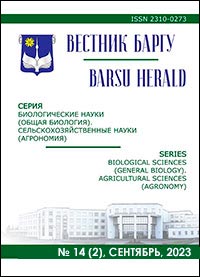ALLOCHTHONOUS FOSSILS IN THE UPPER CENOZOIC DEPOSITSOF BELARUS. PRELIMINARY RESULTS OF THE STUDY.PART II: DEVONIAN — PLEISTOCENE
Keywords:
allochthonous fossils; Devonian; Carboniferous; Jurassic; Cretaceous; Pleistocene of BelarusAbstract
devoted to the fossil remains of Devonian — Pleistocene organisms. Of them, representatives of the Devonian and
Cretaceous marine biota clearly dominate in terms of number, diversity and geographical distribution. This conclusion is
supported by the widespread presence of not only macroscopic, but also microscopic remains of Devonian (vertebrates,
microtentaculits, problematic microfossils) and Cretaceous organisms (foraminifers, radiolarians, sponge spicules) in
Pleistocene sediments. These facts may indicate the significant role of local Devonian and Cretaceous deposits as direct sources
of the sedimentary material of the Pleistocene strata of Belarus. At the same time, the geographically remote (erratic) origin of
some Devonian allochthonous fossils is indisputable. Jurassic and Cenozoic fossils are relatively rarer, and include both
erratic (most Jurassic samples) as well as reworked from local bedrock sources (Paleogene and Neogene).
Allochthonous specimens of Permian and Triassic flora and fauna in the Pleistocene of Belarus have not yet been found.
Among the least studied issues of paleontology of the Pleistocene sediments of the territory of Belarus is the occurrence of
subfossil samples of marine organisms, which can have both anthropogenic origin and be the result of natural reworking.
Some of these finds may be evidence of the Late Cenozoic sea basin, which extended to the northern regions of the country.
Fig. 54. Ref.: 24 titles.
Downloads
Published
Issue
Section
License
Copyright (c) 2023 Вестник БарГУ Серия "Биологические науки. Сельскохозяйственные науки"
Это произведение доступно по лицензии Creative Commons «Attribution-NonCommercial» («Атрибуция — Некоммерческое использование») 4.0 Всемирная.
Авторы сохраняют за собой право заключать определенные договорные соглашения, касающиеся неисключительного распространения опубликованной версии работы (например, размещать ее в институциональном репозитории, публикация в книге) со ссылкой на ее первоначальную публикацию в этом журнале.





